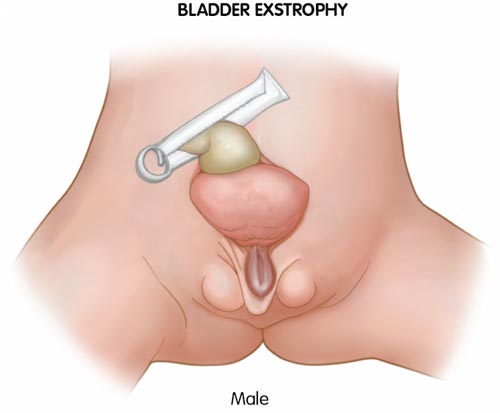Bladder Exstrophy
Bladder Exstrophy
Bladder exstrophy is an uncommon birth abnormality that arises during the early stages of fetal development. The developing baby’s abdominal wall and surrounding organs do not correctly fuse together.
The bladder of the newborn is exposed on the exterior of the body. This is a complicated disorder that affects the urinary tract, reproductive tract, digestive tract, and musculoskeletal system. It also causes improper bladder and pelvic formation.
Bladder exstrophy affects about 1 in every 40,000 babies.

Exstrophy is classified into three types:
- Epispadias is a condition that affects the tube that transports urine from the bladder to the outside of the body (urethra). This is a less severe form. Male epispadias affects around one in every 117,000 births. Female epispadias affects around one in every 484,000 births.
- Classic bladder exstrophy affects the bladder, urethra, and genitals. Bladder exstrophy is uncommon. It affects around one in every 40,000-50,000 infants. It is more common in males than in girls.
- Cloacal exstrophy is a condition that affects the bladder, urethra, genitals, and intestines. This is a more severe form. And it affects around one in every 100,000 newborns. It is more common in females.
Diagnosing Bladder Exstrophy
- Prenatal ultrasounds may occasionally detect bladder exstrophy, but the diagnosis is typically established after delivery.
- Regardless of the stage of the diagnosis, the child should be directed to a pediatric urologist who has expertise in treating and managing this unusual ailment.
What is the treatment for Pediatric Bladder Exstrophy?
Surgery
- Surgery is nearly always necessary to treat bladder exstrophy. Many individuals need many procedures over the course of several years as they grow and develop. Most children with bladder exstrophy will have completely functioning and normal-appearing bladders and sexual organs.
- The initial procedure to treat bladder exstrophy is usually performed when the infant is just a few days old. The purpose of bladder exstrophy reconstructive surgery is to first arrange the bladder inside the body such that it functions correctly, and subsequently enhances external looks.
- Pediatric urologists conduct surgeries on patients while they are sedated. They may be given pain or anti-inflammatory drugs to aid in their recovery after surgery. Antibiotics may also be administered to patients to prevent infections as they recover.
- Each patient’s bladder reconstruction and management and therapy of bladder exstrophy will be unique. In most situations, counseling is provided to the patient and his or her family to assist with the transition to each stage of the treatment.
- The bladder will be separated from the abdominal wall and, if required, from the colon during the first procedure. If the size or form of the bladder interferes with function, it may be required to rebuild a portion of the bladder.
- The child will most likely be hospitalized for many weeks after each procedure. Urine tests will be repeated to look for symptoms of infection at the surgery site, bladder, and kidneys.
- The last surgical treatments are normally carried out when the child is old enough to retain bladder control, which is usually around the age of four.
Prognosis
While a long procedure, staged reconstruction provides a positive outlook for children with bladder exstrophy. Approximately 75% of persons treated for this illness will be able to regulate their bladder. The majority of people treated have normal bladder and sexual organ function.
After treatment, patients treated for bladder exstrophy generally have no lifestyle restrictions and the condition has no impact on life expectancy.
For more information & consultation on Bladder Exstrophy, Get in touch with Dr. Adwait Prakash a Pediatric Surgeon in Indore. will help you out in understanding your problem and guide you through every stage of your treatment.
To book your appointment Call: 8889588832.
